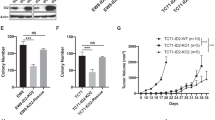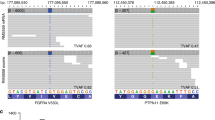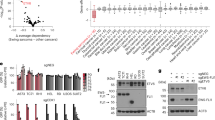Abstract
Ewing's sarcoma (ES) is the prototype of a family of tumors (ESFT) of neuroectodermal origin formed by small, round cells with limited neural differentiation, which arise most frequently within bones in children or adolescents. The proliferation of ESFT cells is highly dependent on the establishment of, and signaling through several growth factor-mediated autocrine loops. The mammalian target of rapamycin (mTOR) is a central regulator of translation and cell proliferation, involved in the cellular response to various nutritional, stress and mitogenic effectors. As mTOR has recently been associated with certain human cancers, we investigated the possibility that mTOR played a role in the regulation of ES cell proliferation. Results showed that ES cell lines carrying EWS/FLI-1 alleles of different types expressed different levels of total and phosphorylated mTOR protein. We demonstrate that rapamycin, an mTOR inhibitor, efficiently blocked the proliferation of all cell lines by promoting cell cycle arrest at the G1 phase. This was paralleled by the downregulation of the levels of the EWS/FLI-1 proteins, regardless of their fusion type, and the concomitant restoration of the expression of the TGF-β type 2 receptor (TGFβ RII), which is known to be repressed by several EWS-ETS fusion proteins. The expression of a rapamycin-resistant mTOR construct prevented both the proliferation blockade and the EWS/FLI-1 downregulation. These data demonstrate that mTOR signaling plays a central role in ES cell pathobiology and strongly suggest that the use of rapamycin as a cytostatic agent may be an efficient tool for the treatment of ES patients.
This is a preview of subscription content, access via your institution
Access options
Subscribe to this journal
Receive 50 print issues and online access
$259.00 per year
only $5.18 per issue
Buy this article
- Purchase on Springer Link
- Instant access to full article PDF
Prices may be subject to local taxes which are calculated during checkout




Similar content being viewed by others
References
Abraham RT . (1998). Curr. Opin. Immunol., 10, 330–336.
Aoki M, Blazek E and Vogt PK . (2001). Proc. Natl. Acad. Sci. USA, 98, 136–141.
Arvand A and Denny CT . (2001). Oncogene, 20, 5747–5754.
Aryee DNT, Sommergruber W, Muehlbacher K, Dockhorn-Dworniczak B, Zoubek A and Kovar H . (2000). Lab. Invest., 80, 1833–1844.
Benini S, Manara MC, Baldini N, Cerisano V, Serra M, Mercuri M, Lollini P-L, Nani P, Picci P and Scotlandi K . (2001). Clin. Cancer Res., 7, 1790–1797.
Daniels GA and Adjei AA . (2001). Expert Rev. Anticancer Ther., 1, 211–221.
De Alava E, Panizo A, Antonescu CR, Huvos AG, Pardo-Mindán FJ, Barr FG and Ladanyi M . (2000). Am. J. Pathol., 156, 849–855.
Decker T, Hipp S, Rongshausen I, Bogner C, Oelsner M, Schneller F and Peschel C . (2003). Blood, 101, 278–285.
Delattre O, Zucman J, Plougastel B, Desmaze C, Melot T, Peter M, Kovar H, Joubert I, de Jong P, Rouleau G, Aurias A and Thomas G . (1992). Nature, 359, 162–165.
Deneen B and Denny CT . (2001). Oncogene, 20, 6731–6741.
Elit L . (2002). Curr. Opin. Invest. Drugs, 3, 1249–1253.
Gingras AC, Raught B and Sonenberg N . (2001). Genes Dev., 15, 807–826.
Girnita L, Girnita A, Wang M, Meis-Kindblom JM, Kindblom L-G and Larsson O . (2000). Oncogene, 19, 4298–4301.
Grolleau A, Bowman J, Pradet-Balade B, Puravs E, Hanash S, Garcia-Sanz JA and Beretta L . (2002). J. Biol. Chem., 277, 22175–22184.
Hahm KB, Cho K, Lee C, Im YH, Chang J, Choi SG, Sorensen PHB, Thiele CJ and Kim SJ . (1999). Nat. Genet., 23, 222–227.
Hidalgo M and Rowinsky EK . (2000). Oncogene, 19, 6680–6686.
Im YH, Kim HT, Lee C, Poulin D, Welford S, Sorensen PHB, Denny CT and Kim SJ . (2000). Cancer Res., 60, 1536–1540.
Kim J and Pelletier J . (1999). Physiol. Genomics, 1, 127–138.
Kovar H, Jug G, Hattinger C, Spahn L, Aryee DNT, Ambros PF, Zoubek A and Gadner H . (2001). Cancer Res., 61, 5992–5997.
Lane HA, Fernández A, Lamb NJ and Thomas G . (1993). Nature, 363, 170–172.
Lin PP, Brody RI, Hamelin AC, Bradner JE, Healey JH and Ladanyi M . (1999). Cancer Res., 59, 1428–1432.
Luan FL, Ding R, Sharma VK, Chon WJ, Lagman M and Suthanthiran M . (2003). Kidney Int., 63, 917–926.
Matsumoto Y, Tanaka K, Nakatani F, Matsunobu T, Matsuda S and Iwamoto Y . (2001). Br. J. Cancer, 84, 768–775.
Nakatani F, Tanaka K, Sakimura R, Matsumoto Y, Matsunobu T, Li X, Hanada M, Okada T and Iwamoto Y . (2003). J. Biol. Chem., 278, 15105–15115.
Rodriguez-Galindo C, Spunt SL and Pappo AS . (2003). Med. Pediatr. Oncol., 40, 267–287.
Sausville EA, Zaharevitz D, Gussio R, Meijer L, Louarn-Leost M, Kunick C, Schultz R, Lahusen T, Headlee D, Stinson S, Arbuck SG and Senderowicz A . (1999). Pharmacol. Ther., 82, 285–292.
Scotlandi K, Benini S, Nanni P, Lollini P-L, Nicoletti G, Landuzzi L, Serra M, Manara MC, Picci P and Baldini N . (1998). Cancer Res., 58, 4127–4131.
Seufferlein T and Rozengurt E . (1996). Cancer Res., 56, 3895–3897.
Shah S, Potter MW, Ricciardi R, Perugini RA and Callery MP . (2001). J. Surg. Res., 97, 123–130.
Toretsky JA, Thakar M, Eskenazy AE and Frantz CN . (1999). Cancer Res., 59, 5745–5750.
Üren A, Merchant MS, Sun CJ, Vitolo MI, Sun Y, Tsokos M, Illei PB, Landanyi M, Passaniti A, Mackall C and Toretsky JA . (2003). Oncogene, 22, 2334–2342.
Visner GA, Lu F, Zhou H, Liu J, Kazemfar K and Agarwal A . (2003). Circulation, 107, 911–916.
Van der Poel G, Hanrahan C, Zhong H and Simons W . (2003). Urol. Res., 30, 380–386.
Zucman J, Melot T, Desmaze C, Ghysdael J, Plougastel B, Peter M, Zucker JM, Triche TJ, Sheer D, Turc-Carel C, Ambros P, Combaret V, Lenoir G, Aurias A, Thomas G and Delattre O . (1993). EMBO J., 12, 4481–4487.
Zwerner JP and May WA . (2001). Oncogene, 20, 626–633.
Acknowledgements
This work was supported by US Public Health Service Grant PO1-CA74175 from the National Cancer Institute, NIH. Technical help was provided by the Flow Cytometry/Cell Sorting Shared Resource of the Lombardi Cancer Center, funded through US Public Health Service Grant P30-CA51008.
Author information
Authors and Affiliations
Corresponding author
Rights and permissions
About this article
Cite this article
Mateo-Lozano, S., Tirado, O. & Notario, V. Rapamycin induces the fusion-type independent downregulation of the EWS/FLI-1 proteins and inhibits Ewing's sarcoma cell proliferation. Oncogene 22, 9282–9287 (2003). https://doi.org/10.1038/sj.onc.1207081
Received:
Revised:
Accepted:
Published:
Issue Date:
DOI: https://doi.org/10.1038/sj.onc.1207081
Keywords
This article is cited by
-
Optimal Management of Ewing Sarcoma Family of Tumors: Recent Developments in Systemic Therapy
Pediatric Drugs (2013)
-
Molecular pathogenesis and targeted therapeutics in Ewing sarcoma/primitive neuroectodermal tumours
Clinical Sarcoma Research (2012)
-
Basic fibroblast growth factor in the bone microenvironment enhances cell motility and invasion of Ewing's sarcoma family of tumours by activating the FGFR1–PI3K–Rac1 pathway
British Journal of Cancer (2010)
-
The choice of the immunosuppressant for the patients of the malignant tumors after kidney transplantation
The Chinese-German Journal of Clinical Oncology (2008)
-
Rapamycin: Something Old, Something New, Sometimes Borrowed and Now Renewed
Clinical Pharmacology & Therapeutics (2007)



